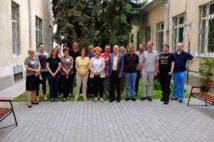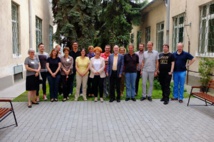
InNet Conference in Budapest (Hungry) in 2014. Source: inNet.
A group of Scientifics funded by the European Union has created an educational web site, Languages in Danger, which contributes to the preservation of endangered languages and offers quality information about this issue to the public.
This web site about endangered languages, developed through the UE funded project InNet, is free and of open access. The web site is based on the previous work carried out by initiatives dedicated to cultural patrimony, and count on search tools, educational material, and interactive maps. It will be very useful to institutes of education and researchers, states Cordis.
“The project was implemented as an answer to the question of how digital – and specifically non-written multimedia cultural heritage resources – could be effectively maintained and preserved for the future,” explains project coordinator Dr. Dagmar Jung from the University of Cologne, Germany. “This challenge has to date not been tackled by the wider scientific and academic community.”
The project team wanted to make these valuable resources accessible to the wider public. “This meant that the educational component of the project took on a bigger role than we initially expected,’ says Jung. ‘In addition to improving networking on digital resource innovation relating to language and culture, the project aimed to boost education on linguistic diversity and multilingualism at the high school level.”
An international summer school for master’s degree and PhD students focused its courses on technological issues of language and music archives and other records of minority languages. “Participating students came from many European countries, but also from Ethiopia, India, and the US,” says Jung.
“Leading scholars in their field gave lectures on technological implementations as well as linguistic background and methodology. In addition, practical tutorials were held by the same instructors so that an immediate learning effect could take place. The summer school was considered highly successful by the students, some of them keeping in close contact with the InNet project and supplying their own data to the website.”
Achievements
Other project achievements include the establishment of five new regional archives and the celebration of annual training events about the use of the accurate and up-to-date standards and tools. Archivists from Argentina, Brazil, Ecuador, Finland, Indonesia, Mexico, Peru, Russia and Sweden, as well as partners from Germany, Hungary and the Netherlands were actively involved in these events.
“Participants at these events were able to present and discuss common issues relevant to the operation of a language archive,’ says Jung. ‘Regional language archives also received additional technical support with the operation of their archive.”
An important predecessor to InNet was the Clarin project, which established a distributed network of organisations hosting language resources and related services. This distributed data network has sites all over Europe, typically universities, research institutions, libraries and public archives. The InNet project succeeded in transferring some of the knowledge acquired in Clarin to a wider network of archives of endangered languages.
This web site about endangered languages, developed through the UE funded project InNet, is free and of open access. The web site is based on the previous work carried out by initiatives dedicated to cultural patrimony, and count on search tools, educational material, and interactive maps. It will be very useful to institutes of education and researchers, states Cordis.
“The project was implemented as an answer to the question of how digital – and specifically non-written multimedia cultural heritage resources – could be effectively maintained and preserved for the future,” explains project coordinator Dr. Dagmar Jung from the University of Cologne, Germany. “This challenge has to date not been tackled by the wider scientific and academic community.”
The project team wanted to make these valuable resources accessible to the wider public. “This meant that the educational component of the project took on a bigger role than we initially expected,’ says Jung. ‘In addition to improving networking on digital resource innovation relating to language and culture, the project aimed to boost education on linguistic diversity and multilingualism at the high school level.”
An international summer school for master’s degree and PhD students focused its courses on technological issues of language and music archives and other records of minority languages. “Participating students came from many European countries, but also from Ethiopia, India, and the US,” says Jung.
“Leading scholars in their field gave lectures on technological implementations as well as linguistic background and methodology. In addition, practical tutorials were held by the same instructors so that an immediate learning effect could take place. The summer school was considered highly successful by the students, some of them keeping in close contact with the InNet project and supplying their own data to the website.”
Achievements
Other project achievements include the establishment of five new regional archives and the celebration of annual training events about the use of the accurate and up-to-date standards and tools. Archivists from Argentina, Brazil, Ecuador, Finland, Indonesia, Mexico, Peru, Russia and Sweden, as well as partners from Germany, Hungary and the Netherlands were actively involved in these events.
“Participants at these events were able to present and discuss common issues relevant to the operation of a language archive,’ says Jung. ‘Regional language archives also received additional technical support with the operation of their archive.”
An important predecessor to InNet was the Clarin project, which established a distributed network of organisations hosting language resources and related services. This distributed data network has sites all over Europe, typically universities, research institutions, libraries and public archives. The InNet project succeeded in transferring some of the knowledge acquired in Clarin to a wider network of archives of endangered languages.


 English
English



